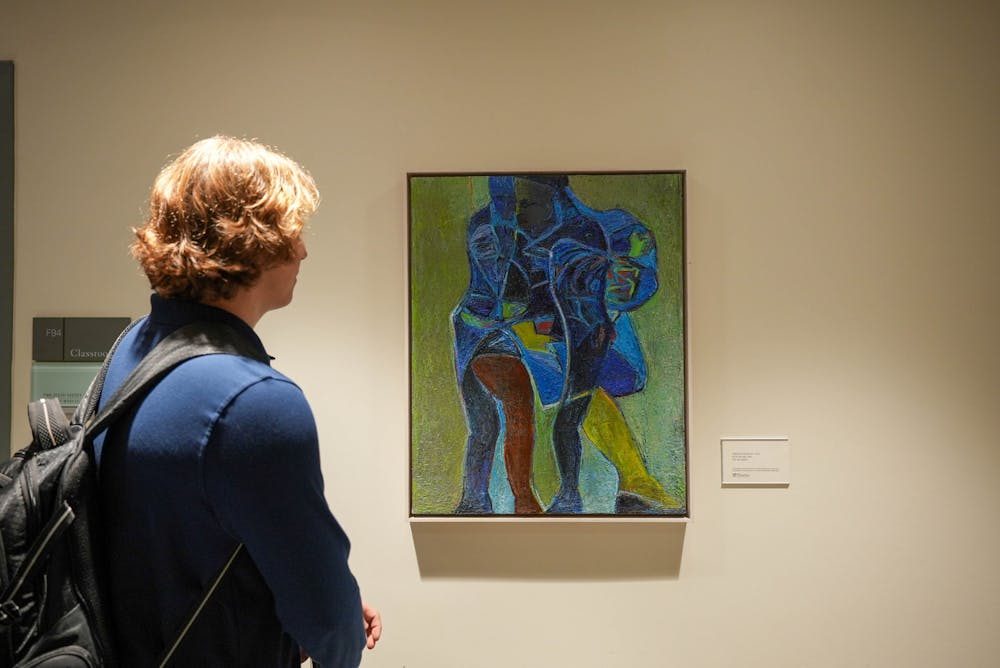In the month that I’ve been at Penn, I’ve started walking twice as fast as I used to. I’ve lost my ability to slow down and look around as I walk through campus. With my headphones in and my head down, I may be getting to my destination on time, but I’m losing out on all of the little details that comprise my walk. The times when I allow myself to walk at my slower, natural pace, I gain control over my life again, and suddenly the trees look a little taller and the Quad looks slightly cleaner and the sun feels ever so slightly brighter. When I appreciate the beauty in my surroundings, or rather, the art in the little pieces of this new world around me, I find myself and can hold onto that feeling when I eventually end up stressed or frantic again.
Art is an extremely broad term that, especially lately, can feel controversial. Who’s to say what qualifies as art? The curator of a museum? The highest bidder? Or ourselves? Some would argue that some things that are sold for hundreds of thousands of dollars or that end up in massive museums shouldn’t even qualify as art—so much so that it’s a popular trend on TikTok to pose in front of pieces of contemporary art (such as Barnett Newman’s 1950 piece, "Vir Heroicus Sublimis") that the videographer feels they could make, despite having no prior artistic experience.
However, what seems to be more relevant than what classifies as art is how these pieces make us feel. Perhaps the point of a highly valued painting that seems so easy to make is the discussion it sparks about whether it even should qualify as art. Like it or not, controversy is conversation, conversation has emotion, and emotion comes from art. Works of art serve as think pieces, no matter where or why they exist where they do. Looking at a painting on a wall removes the viewer from their own life and transports them into the world of the canvas, where the viewer can momentarily teleport to a different reality in which, hopefully, they don’t have two midterms next Tuesday. This is why the art around Penn’s campus, although often overlooked, is so valuable.
Art, especially in public spaces, has a profound impact on a community’s well–being. A recent study to be published in Wellbeing, Space and Society explores the influence of artistic interventions in urban environments and found that “interaction with artistic interventions reduced feelings of anxiety, stress, and negative mood” while highlighting the importance of the setting's restorativeness and aesthetic quality. The presence of art doesn’t just beautify a space—it also has the potential to improve viewers' mental state, even if subconsciously. In the context of Penn, where the pressures of academia weigh heavily on students, the art scattered across campus is not only a visual treat but also a subconscious source of stress relief.
Some of Penn’s art is absolutely unavoidable and unmissable. Take Covenant, for example. Meant to bend the rules of architecture while communicating a sense of spiritual unity, the piece instead most prominently serves as a source of underlying comedic relief when telling a friend to "meet under the Tampons." However, Penn’s campus is home to many artistic gems that get far less attention than the sculptures that adorn Locust.
In the main hallway of Holman Biotech Commons hangs Red Grooms’ "Franklins Reception at the Court of France," a cartoon–style lithograph depicting a satisfied man sitting, surrounded by a slew of well–dressed women vying for his attention. This piece is loose and fun and is more of a gesture drawing than a real portrait, helping to convey the chaotic nature of the scene. The vibrant pastel color scheme enforces the youthful silliness of the obnoxious outfits and decor. Biotech Commons is not a place that myself or my peers would necessarily consider to be teeming with life, energy, or fun, so the piece is a nice refresher and reminder that not everything is really that serious.
In the silent Reading Room of Van Pelt–Dietrich Library lives another criminally under–appreciated piece: "Fields of Transformation." This texturally delightful installation spans the majority of the wall in the Reading Room on the library’s main floor, enhancing the warmth of the peaceful space. In this piece, Claudy Jongstra encapsulates the feeling of wisdom “on its travel from the source—the library—through the head—in a state of knowledge—to the heart” in an attempt to capture the magic of learning. Carrying tranquility into its color scheme, Jongstra dyes some of the Drenthe Heath sheep’s wool with chamomile and indigo, but leaves the majority of the fiber in its original white color to reflect the openness of intellectual curiosity. A fantastic addition to the silent workspace, "Fields of Transformation" serves as a quiet reminder of the ever–evolving nature of learning and personal growth.
A few more pieces to look out for around campus include: "Blue Figure" by Deborah Kahn (Huntsman), "Wixárika (Huichol) Yarn Painting" (Biotech), and "Celebration" by Sam Maitin (Annenberg School of Communications).
Art is all around us at Penn, from gargoyles watching over the Quad to the stained glass windows that embellish the ZBT frat house. Even the glow of leaves under the sun at golden hour can become art if we slow down long enough to notice.
In a world that constantly pushes us to move faster, art reminds us to slow down and reconnect with the present. Whether you’re sitting in a library, walking to class, or cramming for an exam, take a moment to look around. You might be surprised by the beauty—and peace—that’s waiting for you.

